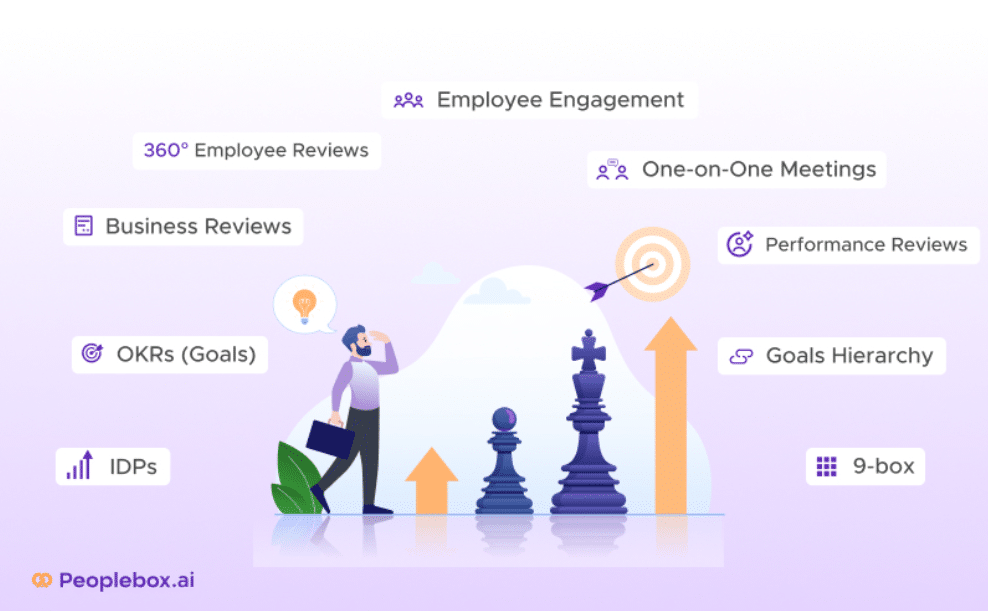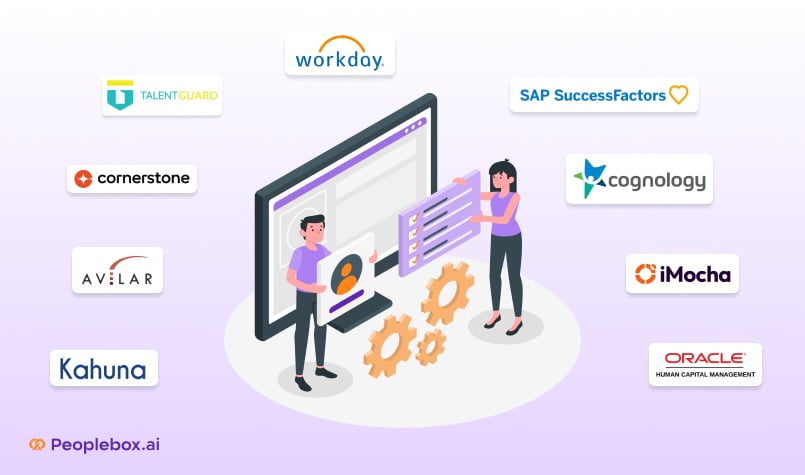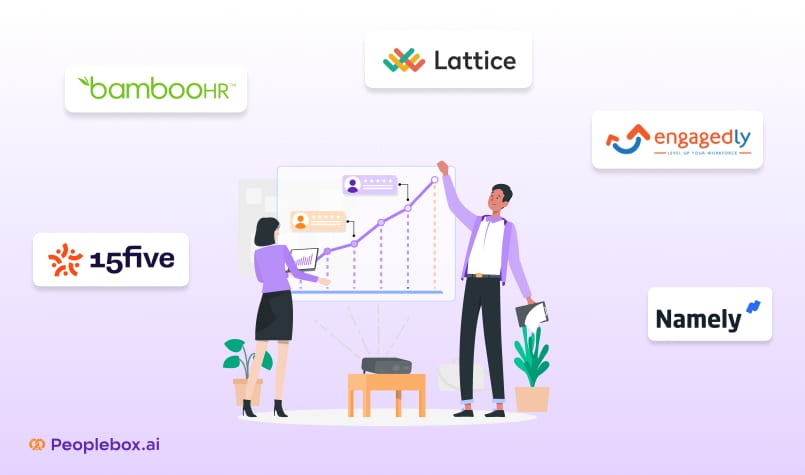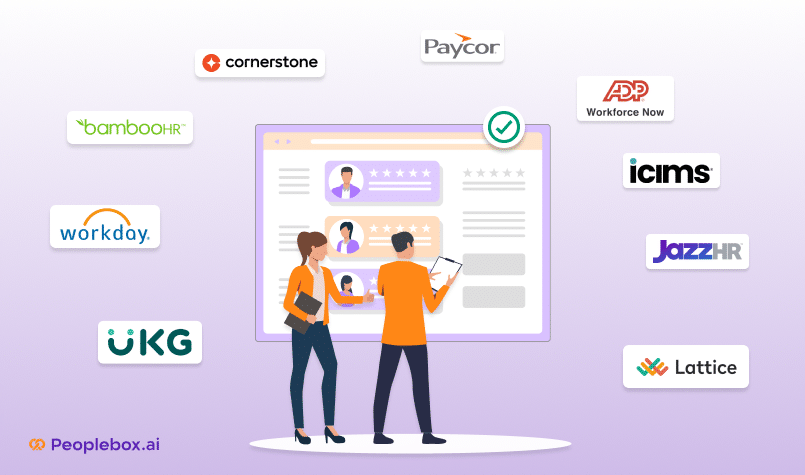Ever wondered what truly makes a performance management system software worth your investment?
It’s not about AI-powered insights, gamification, custom dashboards, or simply what everyone else is using. It’s about driving meaningful growth, improving feedback loops, and helping your team perform at their best. Consistently!
It should feel like an extension of your company’s culture and goals, driving real engagement and delivering results you can see. When it fits your values and how your team works, it stops being just another platform. It becomes a tool for real growth.
So, how do you find the right fit? Let’s break down the key factors that matter most when choosing performance management software — because what works for others might not work for you.
What to Focus On:
- Your company’s specific needs – The right solution should align with your company’s structure and challenges, not just follow industry trends.
- Cultural alignment – A system that reflects your values will feel more natural to use.
- Continuous feedback – Ongoing conversations drive more impact than once-a-year reviews.
- Seamless integration – Compatibility with existing tools makes adoption easier.
- Ease of use – Simple and intuitive systems encourage regular use.
It goes beyond just technology; it’s about building an environment where people can grow and succeed. The right performance management system software will feel like a natural extension of how your team works.
| Not sure what features really matter? Learn how to choose a performance management system that actually drives results. 👉 Find What Works |
The Myth of the “Best” Software
There’s no “best” performance management software—only what’s best for your team. Chasing popular tools doesn’t guarantee success.
Tailored to your needs – A complex system with customizable goal hierarchies, weighted KPIs, advanced reporting, and AI-driven insights might sound impressive, but it can overwhelm a small team that just needs to set clear goals, track progress, and give quick feedback.
On the other hand, a simpler tool with basic goal-setting, performance tracking, and real-time feedback options can be easier to adopt and more effective for smaller teams focused on agility and quick wins.
Don’t fall for marketing hype. Focus on what matters: ease of use, integration with your existing tools, flexibility, and continuous feedback. Software that supports multiple managers and allows for self-assessments and review forms can improve employee feedback and enhance decision-making with accurate employee data.
Today’s teams benefit from regular, real-time feedback—not just annual reviews. Choose software that’s adaptable, aligns with your culture, and evolves as your company grows. Tools that help align employee goals and capture meaningful employee feedback drive better outcomes.
Finding the right tool means looking beyond trends and focusing on a solution that truly fits your organization.
Understanding Your Company’s Unique Needs

Your unique culture and challenges demand a tailored solution, not an off-the-rack system. Let’s look into your processes before diving into the market.
1. Know Your Company Culture and Goals
Assess Your Company Culture
- Identify core company values and integrate them into your employee performance review software.
- Example:
- Innovation and collaboration: Select performance management system software that emphasizes continuous team feedback.
- Efficiency and precision: Choose employee performance evaluation software that offers detailed metrics and streamlined review processes.
Align Organizational Goals
- Clearly define your goals, such as boosting employee engagement, increasing productivity, or driving innovation.
- Match goals to software capabilities:
- Real-time analytics and actionable insights for operational efficiency.
- Goal-setting and robust feedback features for employee development.
2. Review Your Current Processes
Evaluate Existing Performance Management Practices
- Identify gaps, such as infrequent reviews or unclear evaluation criteria, that your new employee performance review software should address.
Collect Employee and Manager Feedback on Performance Management
- Gather insights on existing performance evaluation processes to uncover if they are cumbersome, outdated, or misaligned with actual job performance.
- Utilize these insights to determine essential features for your new employee performance evaluation software.
3. Align Performance Reviews with Business Strategy
Ensure Performance ManagementAligns with Business Objectives
- For growing companies, prioritize scalability and integration features in employee performance evaluation software.
- Ensure your chosen software adapts easily to evolving business needs and supports future expansion.
| Performance reviews not translating to business success? Choose a system that connects employee goals to company outcomes. 👉 Drive Real Results |
Support Long-Term Strategic Goals with Employee Performance Evaluation Software
- Choose software that facilitates continuous learning, career progression, regular performance check-ins, goal adjustments, and tracking.
- Transform performance reviews from administrative tasks into meaningful ongoing dialogues benefiting both employees and management.
Prioritize Value-Added Employee Performance Review Software
- Focus on functionality, flexibility, and ease of use in PMS (performance management system) software rather than superficial marketing features.
- Invest in software solutions that genuinely foster continuous improvement and sustained organizational success.
What to Look for in Employee PMS: The Features That Drive Growth

With so many options out there, it’s easy to get caught up in flashy features that sound good but don’t really solve day-to-day challenges. The key is to focus on what will make life easier for managers and employees while driving real performance improvements. Here’s what to keep an eye on:
Table: Performance Management System Software Features to Consider
| Feature | Considerations |
| Customization and Flexibility | Look for performance management system software that offers customization options for review templates, evaluation criteria, and feedback processes to meet your organization’s unique requirements. |
| Scalability | Ensure the employee performance evaluation software can scale with your company’s growth, easily adding users and new features as your needs evolve. |
| User-Friendly Interface | Prioritize software with an intuitive and easy-to-navigate interface, encouraging regular use and minimizing the need for extensive training. |
| Integration Capabilities | Choose performance management system software that seamlessly integrates with your existing HR systems, payroll software, and digital tools to ensure smooth workflows and data accuracy. |
| Real-Time Analytics | Select software that provides real-time analytics and reporting capabilities, enabling managers to quickly address issues and support continuous improvement. |
| Mobile Accessibility | Opt for cloud-based performance management software accessible from any device, facilitating ease of use and consistent engagement among remote or flexible teams. |
| Security and Compliance | Prioritize solutions with robust data security features, including encryption, role-based access, and compliance with industry standards and regulations. |
| Pricing Structure | Consider the pricing models offered, balancing cost-effectiveness with overall functionality and long-term value. |
By carefully evaluating these features, you can confidently select employee performance review software that genuinely meets your business needs, driving continuous improvement and measurable organizational growth.
| Top 5 Performance Evaluation Software: 1. Peoplebox.ai – Continuous feedback and OKRs 2. 15Five – Employee engagement and tracking 3. Lattice – Performance reviews and goal management Want to dive deeper into how the right performance evaluation software can transform your reviews? 👉 Read “40 Best Performance Management Software in 2025” to learn more |
Matching Performance Tools to Employee Needs
Here’s a structured chart based on different employee segments and their specific performance management needs:
1. New Joiner (0–3 Months)
| Key Needs | Relevant Peoplebox.ai Product | Purpose |
| Clear onboarding process | OKRs | Set clear, measurable goals from day one to give direction. |
| Early feedback and course correction | Continuous Feedback | Ensure quick adjustments and alignment. |
| Role clarity and team integration | 360-Degree Feedback | Provide clarity on team expectations and responsibilities. |
| Manager check-ins | Manager 1:1s | Foster strong manager-employee relationships early on. |
| Performance tracking | AI-Driven Insights | Monitor early performance trends and recommend improvements. |
2. Junior-Level Employee (3–12 Months)
| Key Needs | Relevant Peoplebox.ai Product | Purpose |
| Performance reviews | 360-Degree Feedback | Identify strengths and areas for improvement. |
| Goal alignment | OKRs | Keep individual goals aligned with business goals. |
| Career development discussion | Manager 1:1s | Help employees understand career growth opportunities. |
| Skill building | AI-Driven Insights | Recommend training based on performance gaps. |
| Peer feedback | 360-Degree Feedback | Encourage collaborative feedback from team members. |
3. Mid-Level Employee (2–3 Years)
| Key Needs | Relevant Peoplebox.ai Product | Purpose |
| Career progression | OKRs, Growth Path | Set and track career goals. |
| Fair evaluation | Performance Calibration | Ensure consistent and unbiased performance reviews. |
| Professional growth opportunities | AI-Driven Insights | Identify growth areas and skill gaps. |
| Feedback from multiple sources | 360-Degree Feedback | Provide a complete view of performance. |
| Recognition and reward | Manager 1:1s | Create opportunities for recognition and motivation. |
4. Senior-Level Employee (5+ Years)
| Key Needs | Relevant Peoplebox.ai Product | Purpose |
| Promotion readiness | Performance Calibration | Ensure fair and transparent evaluation for promotions. |
| Leadership development | 360-Degree Feedback | Identify leadership skills and areas for improvement. |
| Strategic goal setting | OKRs | Align personal goals with company strategy. |
| Retention and motivation | Manager 1:1s | Keep senior employees motivated and engaged. |
| Peer and cross-functional feedback | 360-Degree Feedback | Broader feedback to support strategic decisions. |
5. Leadership and Strategic Role (10+ Years)
| Key Needs | Relevant Peoplebox.ai Product | Purpose |
| Leadership impact measurement | AI-Driven Insights | Track how leadership decisions affect business goals. |
| Business-wide goal alignment | OKRs | Ensure that executive goals drive business growth. |
| Strategic decision support | AI-Driven Insights | Provide insights to guide high-stakes decisions. |
| Leadership consistency | Performance Calibration | Maintain consistent leadership performance standards. |
| Cross-functional collaboration | 360-Degree Feedback | Ensure executive alignment with other business units. |
Now that we’ve explored the different employee needs, let’s dive deeper into how Peoplebox.ai makes it all happen.
Ready to Implement? Here’s How to Integrate Your Performance Management Software
Implementing and integrating employee performance review software is a key step toward building a culture of continuous feedback and improving overall performance. A successful rollout requires more than just setting up the software—it’s about making it part of your organization’s daily operations. With the right strategy, effective communication, and ongoing support, you can ensure smooth adoption and long-term success.
1. Engage Key Stakeholders Early
To successfully implement employee performance review software, it’s important to involve key stakeholders such as managers, HR professionals, and IT teams early in the process. Collaboration helps anticipate challenges and align the software with existing workflows.
Clear communication about the benefits and changes will ease concerns and help employees feel more comfortable with the transition. A well-planned employee review process sets the foundation for effective adoption and use.
2. Provide Thorough Training
Training is crucial for the successful adoption of any performance management tool. Make sure all users, from executives to frontline employees, understand how to navigate the system and use its features effectively.
Conduct hands-on training sessions supported by online tutorials and detailed guides. Proper training increases confidence and reduces resistance to change, making it easier for teams to track and improve employee performance.
A well-trained team will be more engaged in the employee review process and more likely to adopt the system.
3. Integrate Seamlessly with Existing Systems
A smooth integration of the new employee performance evaluation software with existing HR systems, such as payroll and talent management platforms, is essential. Proper integration reduces data silos, improves data accuracy, and allows real-time tracking of employee performance.
A connected system enhances decision-making and ensures that performance insights are readily accessible across teams. The more streamlined the process, the more effective the performance management tool will be in driving outcomes.
4. Set Clear Performance Metrics and Goals
From the outset, define clear goals and success metrics for the performance management system software. Configure the software to track key performance indicators (KPIs) and provide actionable insights.
Regular check-ins and feedback loops allow you to monitor progress and make adjustments as needed. Tracking employee performance in real time helps identify strengths and areas for improvement.
Ensuring the system remains effective as business needs evolve helps maintain consistency and drive better results.
5. Establish a Feedback Loop
After the system is in place, gather feedback from users to identify any issues or opportunities for improvement. Conduct post-implementation reviews to ensure the software continues to meet your organization’s needs.
Incorporating user feedback strengthens the overall employee review process and enhances employee satisfaction. Addressing concerns promptly makes the performance management tool more effective and increases overall adoption rates.
By focusing on stakeholder alignment, comprehensive training, seamless integration, and ongoing feedback, you create a resilient performance management system software that drives employee engagement, improves employee performance, and supports long-term business success.
Boosting ROI: Making the Most Out of Your Performance Management System
Investing in a performance management system software is about more than just technology; it’s about driving measurable business results. A well-implemented employee performance review software can boost employee engagement and productivity while fostering a culture of accountability.
Set Clear Objectives
- Define clear goals for your performance management system software—whether improving engagement, increasing productivity, or driving innovation.
- Use real-time analytics to measure progress and adjust your approach as needed.
- A structured performance review process helps track performance and align it with business goals.
Engage Your Employees Early
- Early engagement increases adoption of HR performance management software and boosts productivity.
- Clear feedback, personalized development plans, and transparent metrics improve employee confidence.
- A structured performance review process creates accountability and encourages growth.
Provide Ongoing Training
- Regular training ensures effective use of all features in your HR performance management software.
- Continuous education helps teams follow the performance review process consistently.
- Well-trained teams are more confident and productive.
Leverage Data for Strategic Decisions
- Use insights from your performance management software to identify trends and improve strategies.
- Data-driven decisions enhance employee performance and business outcomes.
- A strong HR performance management software supports long-term success.
Ensure System Security and Stability
- Is your performance management software secure? Data protection is essential for trust.
- Ensure your employee performance evaluation software complies with regulations.
- A secure system builds confidence and supports reliable performance management.
By setting clear goals, engaging employees, providing training, and leveraging data, you maximize the ROI of your HR performance management software. A secure and well-integrated system drives continuous improvement and business success.
| Not seeing the ROI you expected? Discover how the right system can drive measurable results and employee growth. 👉 Boost Performance Now |
Facing Issues? Overcome Common Performance Management Challenges
Implementing a performance management system software brings significant benefits, but challenges like resistance to change, integration issues, and user adoption can arise. Success lies in identifying these hurdles early and addressing them strategically.
1. Resistance to Change
Resistance is natural when introducing a new employee performance evaluation software. Engage employees through meaningful conversations about its benefits and how it aligns with organizational objectives.
Open communication, regular collecting feedback, and ongoing training help address concerns and increase adoption rates.
2. Integration Challenges
Integrating employee performance review software with existing tools can be complex. Choose a compatible system and work with IT to prevent data silos and ensure security.
Seamless integration allows for real-time performance reports and better performance feedback, improving decision-making.
3. Inconsistent User Adoption
Ensure consistent adoption through training and regular communication. Encourage managers to use the system for providing constructive feedback and tracking organizational objectives.
Creating a culture of continuous meaningful conversations and regular collecting feedback increases system value.
4. Ensuring Effective Feedback Loops
Continuous collecting feedback helps identify issues and adjust strategies. Managers should deliver consistent performance feedback and provide constructive feedback to improve outcomes.
Encouraging two-way feedback builds trust and helps identify skill gaps for better goal alignment.
5. Leveraging Performance Reports
Regular performance reports help track progress and identify areas for improvement. Analyzing trends improves employee development and aligns with business goals.
A data-driven approach to employee performance evaluation software ensures continuous improvement and better results.
Looking Ahead: Future Trends in Employee Performance Management
The future of performance management is evolving rapidly, driven by technology and a growing focus on employee well-being. Here’s what to expect:
- Shift to Real-Time Feedback
Future performance management system software will focus on continuous, real-time feedback rather than periodic reviews, allowing for quicker adjustments and more responsive performance management. - Advanced AI and Predictive Analytics
AI-driven insights will help adjust performance strategies and create personalized development plans, improving decision-making and employee growth. - Holistic Employee Well-Being and Engagement
Future employee performance review software will track not only productivity metrics but also employee satisfaction and engagement levels, fostering a more balanced and healthier work environment. - Data-Driven Performance Improvement
Aligning feedback with performance reports and organizational objectives will create a high-performing workforce. Regularly collecting feedback and analyzing trends will drive long-term success.
Staying ahead of these trends with timely feedback will help organizations build more adaptable, engaged, and successful teams.
Close the Feedback Gap: How Peoplebox.ai Turns Reviews Into Practical Insights

“If you’re an HR leader watching your performance reviews flop harder than that office holiday party karaoke, don’t worry—it’s probably just your dinosaur software to blame. (Yeah, it’s ancient and overdue for extinction!.)”
Performance reviews shouldn’t feel forced or disconnected from day-to-day work. Peoplebox.ai helps you build a system where feedback, goal tracking, and growth become part of the regular workflow—not just a year-end event.
Here’s how it makes a difference:
- Meaningful check-ins – Regular, structured conversations that help employees feel supported and give managers the insights they need to adjust course early.
- 360° feedback – Capture input from managers, peers, and direct reports to create a well-rounded view of performance and development needs.
- Goal alignment – Track progress against individual and company goals in real-time, so everyone knows where they stand and what to focus on.
- Smart talent mapping – Use 9-box grids and AI-driven insights to identify high performers, spot skill gaps, and build development plans.
- Simple to use – The system is intuitive enough that even Bob from accounting—who still prints his emails—can navigate it without trouble.
With Peoplebox.ai, growth becomes part of how your team operates every day. No more scrambling before review season—just consistent progress and better results.
How Well Do You Know Performance Management?
You’re checking in with your team. How do you make sure it’s more than just a casual chat?
Hold one-on-one meetings to give personalized feedback and track progress. These are your chance to dive deep into challenges and set the stage for growth.
Want to know how your employee is really doing? Ask everyone around them!
Use 360-degree feedback for a full-circle view. Get insights from managers, peers, and reports to spot strengths and areas for improvement.
Got a star performer? How do you know if they’re ready to level up?
Use the 9-box grid to evaluate performance and potential. This helps identify top performers and future leaders who are ready for promotion.
How do you keep your team focused on what matters most?
Set OKRs (Objectives and Key Results) to align everyone with clear goals. This ensures everyone’s working towards the same big picture.
| “Want to see similar improvements?” Discover how aligning feedback with goals can drive measurable results. 👉 See How It Works |
Meet Tara and Nova: The AI Duo Transforming Talent and Performance Management

Peoplebox.ai isn’t just another player in performance management—it’s the first to bring AI agents like Tara and Nova into the mix, making talent management feel effortless.
Tara is the hiring pro. No more drowning in resumes or chasing down candidates—Tara’s got it covered. She keeps the talent pipeline flowing, so you can focus on building a team that actually clicks instead of getting stuck in the admin weeds.
Nova is the growth guru. Performance reviews don’t have to be a guessing game. Nova spots skill gaps before they become problems and helps shape development plans that actually work. When your team grows, so does your business—it’s that simple.
With Peoplebox.ai, HR stops being about spreadsheets and chaos. Tara and Nova handle the heavy lifting so you can focus on what really matters—building an engaged, high-performing team.







